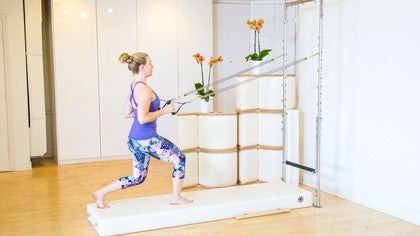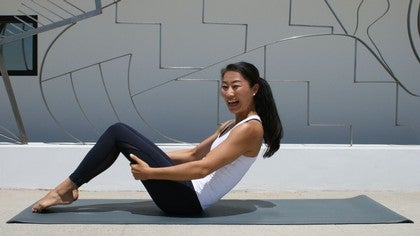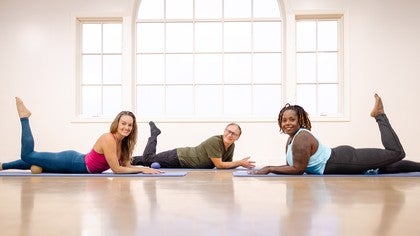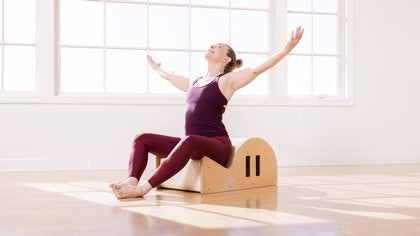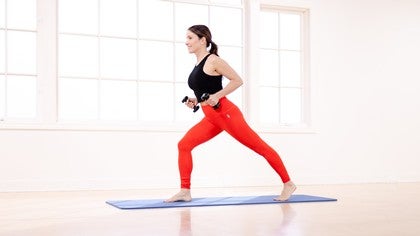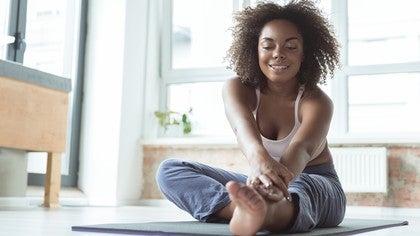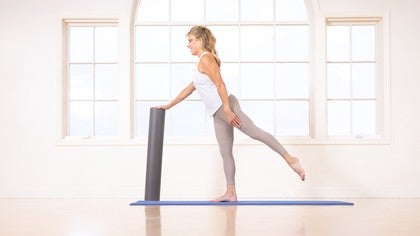
Top 10 Pilates Props for Mat Classes
If you regularly attend Pilates Mat classes, you’ve probably used props. These are small items like balls and bands that studios provide to enhance your Pilates workout. By isolating or engaging specific muscles, props can foster "a-ha" moments even during the most familiar exercises. Like the springs on a Reformer, props can provide support and stability or offer more challenge, depending upon the movement being performed and how they are used. Creative instructors rely on props to add variety and a “secret sauce” to the traditional repertoire of Mat exercises. Here are some of the most commonly used Pilates props and how and why we use them.
These Pilates Props Can Enhance Your Workout
1. Foam Roller
This versatile prop, a mainstay of athletic training and rehab, is designed to smooth out the fascia. Its rounded shape, however, means that it can pinch-hit as a Spine Corrector. The wobbly surface challenges balance. Try performing Arm Circles, Knee Lifts, Toe Taps, or Dead Bug while your spine rests atop the Roller. Or turn it horizontally and rest your pelvis on the Roller while working up to the Shoulder Bridge, or performing a spring-less Leg Spring Series. Placed beneath the shoulder blades, the Foam Roller offers support in Abdominal Curls and facilitates spinal extension.
2. Hand Weights
In Pilates, we use light Hand Weights to keep the emphasis on the entire body. One- or two-pound weights add challenge to the Standing Arm Series and the Wall Exercises. They also make a good stand-in for the Arm Springs on the Cadillac and the handles on the Reformer. Many Reformer exercises, from Coordination to Rowing to Backstroke, can be done on the Mat using Hand Weights.
3. Theraband
This long, stretchy band, available in varying levels of resistance, is great for stretching the hamstrings and lower back while lying on the Mat. The band can add resistance and challenge in the Side-Lying Leg Series, and it provides support and stability in exercises such as the Roll Up, Roll Back, and One Leg Circle.
4. Overball
This squishy inflated ball is one of the most versatile and commonly found props in a Pilates studio. When placed between the inner thighs, ankles, or palms, the Ball invites the engagement of the surrounding muscles. It’s also a great modification tool when placed under the spine or hips for extra support. Pregnant women can use a Ball behind the mid-back to avoid lying supine (flat on the back) for an extended period of time.
5. Tennis Ball
Joseph Pilates invented several small pieces of Pilates equipment specifically to engage and work the feet, most famously the Foot Corrector. The small size and firmness of Tennis Balls make them ideal for waking up the feet. Try rolling the sole of the foot over a Tennis Ball while standing or seated. Tennis balls can also be placed under tender areas such as the hips or shoulders for a static stretch or gently rolling massage.
6. Franklin Ball
These small, inflatable balls are used to massage and wake up the muscles and fasciae. Placed beneath the pelvis, lower back, shoulders, or other tight or sore spots, Franklin Balls work with the body’s own weight to release tension. These balls can be used for static holds or you can slide them back and forth across the fasciae for a self-massage.
7. Pole
Short, weighted poles can stand in for the Cadillac’s Roll Back Bar in exercises such as Breathing and Thigh Stretch. Adding a Pole to the classic Roll Up exercise adds resistance and challenge on the way up from the floor and contributes to a great stretch in the forward rounding position.
8. Magic Circle
Perhaps the most well known and versatile of all the Pilates props, this deceptively simple tool has endless uses. A Circle held between the ankles, thighs, or palms is a useful tool for finding the mid-line, an important Pilates principle (think of the phrase “drawing in and up”). The Magic Circle can also create instability (the same way an Overball does) when balanced on the floor beneath an outstretched hand in the Side-Lying, or Side Kick Kneeling, or under the ankle of the stationary leg in the One Leg Circle. There’s also an entire standing series performed with the Circle placed above and between the ankle bones — a major balance challenge.
9. Chair
Just as there is something called “Chair Yoga,” many Pilates exercises can be modified so that they can be done in a seated position. Sitting upright is especially beneficial for beginners, as it encourages length in the spine (the same effect can be achieved by sitting on a Foam Roller or a Yoga Block). Try Spine Stretch Forward, Spine Twist, or the Saw, for starters. There are also the so-called TV Exercises that teach trunk stabilization. Bonus: you can do these on an airplane or at your desk.
10. Yoga Block
In yoga classes, blocks are commonly used to bring the floor closer to you in Forward Folds. In Pilates Mat classes, these firm but not rigid foam blocks can take the place of a Magic Circle or an Overball. They can prop up the sacrum in a Shoulder Bridge and provide a useful perch in any of the seated exercises. Lightly hugging a block between the hands in Single Leg Kick engages the back muscles and upper arms. A pair of blocks placed beneath the hands can help make Leg Pull Back more accessible.
Try adding props to your Mat work and see if it doesn’t challenge you in interesting ways and reveal new information about the exercises and your body. You can find many of the props mentioned above at for sale at local Pilates studios, physical therapy supply stores such as OPTP (Orthopedic Physical Therapy Products), Pilates equipment manufacturers like Balanced Body, or even on Amazon.
Once you have your props in hand, check out Pilates Anytime, where you can search for Mat classes by level, duration, and even which props, if any, are used.
Comments
You need to be a subscriber to post a comment.
Please Log In or Create an Account to start your free trial.












